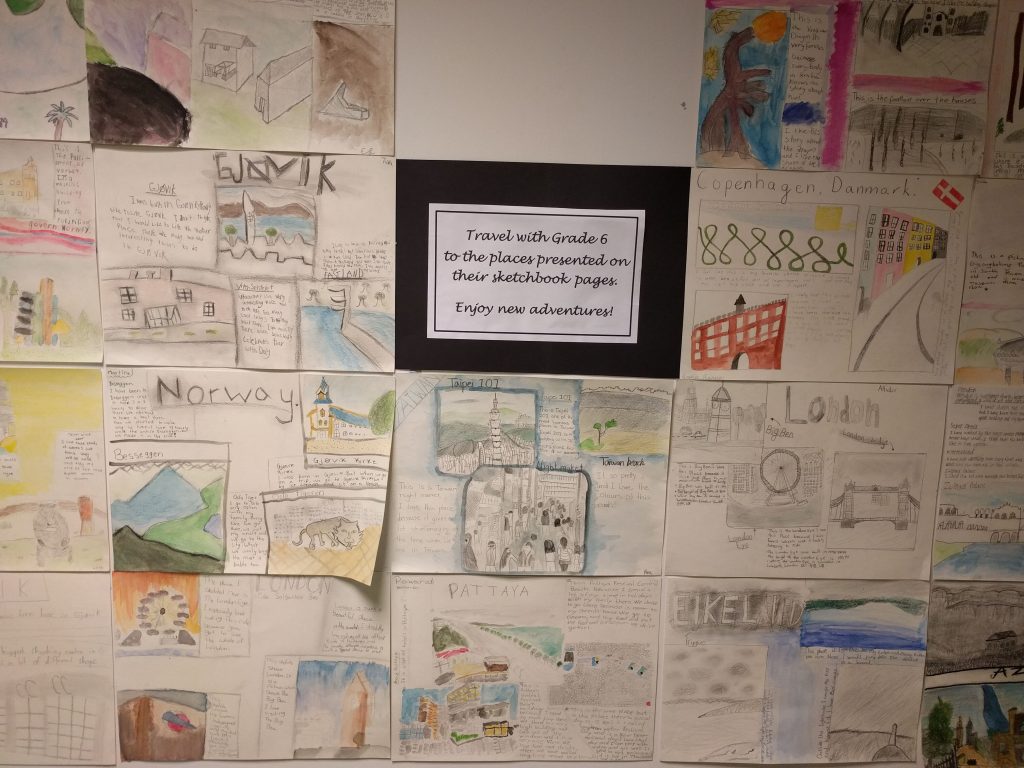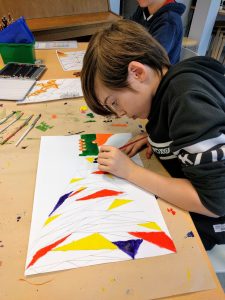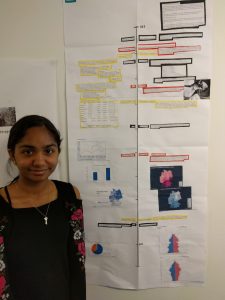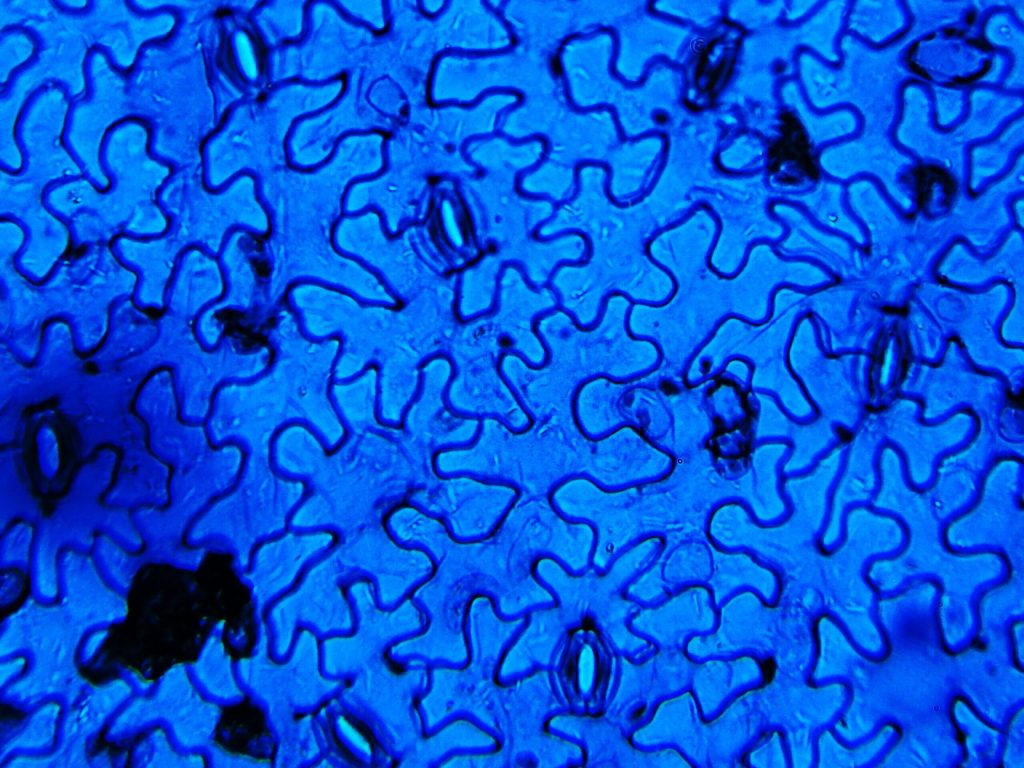This blog is part of a series about using interdisciplinary units (IDUs) in MYP schools with a small student population. Read the first blog here.
“In each year of the programme, schools must address all four objectives (every strand) of interdisciplinary learning.”
Our tiny MYP school, which started with just 19 students in 2016, assesses the IDU criteria holistically through student reflections. In addition, each unit also assesses a variety of disciplinary strands holistically or formatively (Table 1). Informal approaches to integration, such as unit alignment and STEM activities, are also frequent.
There are multiple forms of integration and entry points for interdisciplinary planning. In our experience as a start-up school, several IDUs were inspired by the acquisition of new resources. Examples include LCD Digital Microscopes which can be shared between groups of up to four students, data visualization software and cheap, locally available materials such as PVC tubing.
Student voice: products and reflections
Student reflections provide valuable evidence for the effectiveness of IDUs as a strategy for evaluating ‘learning how to learn’. Through their application of programme-specific language, these students are developing skills that will help them successfully complete the culminating task of the MYP, their Personal Project report.
In their own words, the selected quotes below demonstrate students’ developing articulation as communicators and ambassadors for the MYP.
All examples shown below were selected from work completed during the 2018-19 academic year.
Global connections

Lala, MYP1
It let me know I am connected to different places …. for example, if my [clothes are] from China and then I am connected to China.
Sophia, MYP1
When writing the interesting text about Taiwan’s region I added adjectives to spice up the text and changed boring words to new ones. This skill was also used in art. […] The combined project really helped me because I learned more how to present different elements of knowledge in one poster/ presentation.
Erik, MYP1
The positive about this project was that we cooperated in different subjects. To example we [thought] in all subjects about connections. This helped us learn better about global connections. The negative about to work on one project with three subjects is that if we did not finish the project with just one subject, we needed to drag out the time on all three subjects.
Truls, MYP1
It helped me learn more because I could use a lot of my skills from each subject and that helped me develop better skills on the skills I used. …… [The map] helped me understand how many places I am connected to, just using friends and family [… It’s] so cool knowing that you can be connected to Australia and you’re from Norway.
Shining a light on art

Lukas, MYP2
If an artist learns about light and reflection, it would be a lot easier for the artist to illustrate reflection and how reflections work. Artists can also develop other skills for science; for example, how to illustrate light in an artwork.
Inger, MYP2
Some of the skills we learned about in Visual Art and Science can be applied to other MYP subjects. For example, the ray diagram skills can be applied to mathematics because there are different angles and degrees on the angles. The skills we learned in Visual Art can be applied to Design, for example, the principles of composition […] when making a design.
Emil, MYP2
The learning has made me analyse artworks in everyday life, like when I am going to a museum. Something I do is to appreciate the artwork through aesthetics and not my personal point of view but also […] the elements of art and principles of composition. I have learned how to analyse artworks and see things I have never seen before. I now understand light in a completely different way than I did before.
A problem I had was that I was using too much time on painting my final artwork, reason being because I did not use tape. I learned from my mistake and used tape throughout the rest of making the artwork. This skill can be transferred to other places of my life, because it is about working smarter, not harder. [When making the kaleidoscope] the end cap of the Petri dish turned the paper covering the areas not used. I solved this problem by …[removing] the paper. The easy way is sometimes the best way.
This project developed my understanding of the global context because I understood that Personal and Cultural Expression is so much more than painting and rituals, it is also about what shapes us into who we are.
Roshan, MYP2
Science can only inform artists to a certain extent. Science can inspire artists to create new types of artworks, through giving ideas and patterns to their artwork using light, […] science cannot create the whole design and send a meaning to the audience.
Hedda, MYP2
I developed as a learner because I got a deeper understanding of how the two completely different subjects can be connected. I also understood how the two different subjects depends on each other. I learned that to make good artworks you should have some scientific knowledge before you start, easy example would be that if you want the artwork to look shiny, you should place it in a spot where it is light, and not in shadow, because then few colours will be reflected. So, without the two subjects being connected, the outcome of each subject is limited.
Elias, MYP2
In IDUs generally, I start to understand more and more how two subjects interact with each other. All in all, the two subjects carry each other towards a better product, and that is what I really enjoy about IDUs.
In IDUs you have to combine two subjects which perhaps do not have anything in common when you first look at them. …When I was introduced to the Art & Science IDU, … I had no idea how art and science could relate to each other. When we started to understand the subjects’ roles, it was like two puzzle pieces saying ‘click!’ Such as, when we learnt about mirrors in science, we learnt about anamorphosis in art.

Why is Berlin a divided community?

Advaita, MYP3
When looking at Interdisciplinary units overall, we see that there are many benefits of having and IDU every year. Transferring knowledge from one discipline to another is an extremely useful skill and can benefit us in every field. In addition, to be able to complete the task, you needed skills from both disciplines, and these specific skills were talked about in the paragraphs above. Another important point may be that the skills we used in this unit is quite transferable. Apart from writing in the language German, all the skills we used would be transferable and helpful in other subjects/fields. For example, the statistics we had to use or make in this unit can be very helpful in our Science experiments. Every skill mentioned in the last paragraph, is also transferable to every MYP subject we study. For example, our researching skills are used in every class, and so are our time-management skills. Looking from a different perspective, even writing in German could have been useful if we were studying another language which was similar to German, as it would have helped us widen our vocabulary.
Eirun, MYP3
I did not have German, but I learned about German history. This helped me to understand the timeline of the history of Germany and find the mathematical components, such as death toll and life expectancy. Because I learned about the German history I understood the background of the statistics for the mathematics part. I learned how to create different types of graphs based on numbers provided in statistics, and about how graphs can present misgiving information. I learned that I should draw my graphs big enough to be easy to read and not to mix data. This skill is possible to transfer to other MYP subjects, such as I&S. In I&S we can use this skill of graphing because we can communicate the history by using statistics and graphing.
Another skill I used during this project was research about the German history and the statistics in it. This skill can be transferred to MYP subjects such as Art, because in the amazing art presentations unit we had to research about three artists and use the data we found to compare them as art curators. I also had to be a critical thinker when I did research and decided what to include in my timeline, because I had to be able to pick the information that was relevant to the timeline and not searching about all other factors, such as obesity in Germany. A third skill that I used in this IDU was organization skills, which I used to organize my information, my research, my sources, and my papers and the physical timeline. This skill is one I use in all other subjects. In science I need organization skills when doing practical work, I usually have a lot of equipment on my table at once, such as for instance test tubes, a timer, my science book, and writing equipment, and if I am not organized then accidents may happen that breaks expensive equipment. I need to be organized to avoid this in the future. Creative thinking is a skill I also used both in this IDU and in other subjects; in this IDU I used this skill to make the presentation of the timeline and the shape and the background. One subject I use this skill in is English, where we are doing a unit on writing short stories. In this unit I have to be creative when creating the story, the plot, the characters, and the message.
Ingeborg, MYP3
This project helped me notice connections that I never really think about, and made me more aware of small detail. This project made me develop critical thinking. When it comes to graphs, I can now see if it is misleading or a good source. I think doing a project similar to this every year would be helpful for me as a developing learner seeing connections. This was overall an effective unit for me, and I hope we will do something like this again.
Jaihui, MYP3
Normally, we usually think that Mathematics and Languages or history have no connection, but after this unit, I found out that mathematics can be described in different languages and mathematics can be used to imply some more details to the history […] All skills and knowledge are connected to each other, whether it is a skill you learnt in school, outside of school, you can still apply a specific skill onto another skill to maybe perfect it or improve it.
What can a microscope contribute to geometry?

Oliver, MYP 4
When we look at the big picture, all the skills we learn are connected.
Using both mathematics and science in an interdisciplinary manner for this project was very meaningful. First of all, mathematics was the tool I used to calculate and measure the size of the cell. But measuring cells would be useless without knowledge of how to operate microscopes, or without knowing what a cell looks like.
Olaf, MYP 4
Skills taught in maths and science added a new layer of experience […] I not only experienced […] real world contexts… this task also went beyond the territory of each individual subject, as this is something a professional scientist may do.
Bashar, MYP 4
My mathematical communication skills supported me answering my science communication skills in different ways. …as when I had to compare and contrast my examples of prepared slides and then support my answers by suggesting geometric forms. It was like building me up, it was like layers…. You would not be able to build further without enough information supporting from below, but if you did you would be a risk taker.
I don’t know if the information I provided is better than the internet can provide… but I can tell my information is mostly right. I realised some mistakes were made when the answers were not realistic.
Sigurd, MYP 4
To summarise how this project helped me as a learner, with this project I feel that I can overcome any challenges in other subject or real life. …this project developed me because it always made me check my work. Even the day after that I needed to check my work before submission I discovered that I hadn’t written the unit for one of my scientific notations. This IDU has developed me into a more open minded and principled learner.

Table 1 (see below): Case study – IDU development over three years of practice in a new, candidate MYP school
Subject combinations
- Individuals & Societies
- Language acquisition, English (phase 3-4)
- Visual Arts
Global context GC
- Identities & Relationships
Key Concept KC
- Global interaction
Related Concept(s) RC
- Globalization, Identity, Perspective
- Audience, Conventions, Purpose, Word choice
- Composition, Presentation
Unit name
- Global Connections
Individuals are connected to the world in a variety of ways. Interactions between people and place show that we are living in a globalized society.
Product concept summary
- Students make a global connections map showing connections to a variety of places using themes from Geography to illustrate the connection (5 themes, plus descriptions and illustrations from Art and English).
- Students write about the same place in three different texts, altering the TAP accordingly (text type, audience, purpose).
- Students create a page from a sketchbook to represent, through sketches/watercolour sketches, and through writing, one place from their IDU summative Global Connections Map.
Assessment criteria
- Criterion A, C and D in I&S
- Criteria C and D in Language acquisition, English
- Criteria A, B, C and D in Art
Subject combinations
- Music
- Sciences
Global context GC
- Personal and cultural expression
Key Concept KC
- Change
Related Concept(s) RC
- Composition, Expression
- Function, Transformation
Unit name
- The science of music
- Musical function can be changed through personal expression, in which transformation of a composition is achieved by the quality of sound.
Product concept summary
- Students perform music on PVC flutes made in a ‘waves and sound’ unit in science. Examples can be viewed here.
Assessment criteria
- Criteria A, B, C and D in Music
- Criterion D in Sciences
Subject combinations
- Sciences
- Visual Arts
Global context GC
- Personal and cultural expression
Key Concept KC
- Change
- Aesthetics
Related Concept(s) RC
- Interaction, Transformation
- Composition, Expression
Unit name
- Shining a light on art
- Artists may use scientific interactions to transform aesthetic elements to create compositions that express their changing ideas.
Product concept summary
- Students create an original art work inspired by images taken with smartphones through kaleidoscopes made in a ‘waves and light’ unit in science.
Assessment criteria
- Criteria A and D (i, ii only) in Sciences
- Criteria A, B, C and D in Art
Subject combinations
- Language acquisition, German (phase 2-3)
- Mathematics
Global context GC
- Fairness and development
Key Concept KC
- Change
Related Concept(s) RC
- Quantity, Representation
Unit name
- Why is Berlin a divided community?
- Statistics and graphical representations can be used to analyse, develop, and make explicit (clarify) how communities experience social change.
Product concept summary
- To demonstrate understanding of how social change is made explicit in mathematical data and its analysis, students provide a complex explanation of German history using a timeline that spans 1900 -2000 and comment, in German, on events in the illustrated novella ‘Die Lisa’.
Assessment criteria
- Criteria C and D in Language acquisition, German
- Criteria C and D in Mathematics
Subject combinations
- Mathematics
- Sciences
Global context GC
- Scientific and technical innovation
Key Concept KC
- Relationships
Related Concept(s) RC
- Measurement, Model
- Form, Models
Unit name
- What can a microscope contribute to geometry?
- The measurement of geometric forms helps people model cellular relationships revealed by technological innovations such as microscopes.
Product concept summary
- Students apply 3-D geometry and scientific notation to model plant & animal cells, based on their analysis of micrographs of plant and animal cells taken using a Celestron LCD Digital Microscope II in science.
Assessment criteria
- Criteria C and D in Mathematics
- Criterion C (i,ii only) in Sciences
Subject combinations
- Language & Literature, Norwegian
- Visual Arts
Unit name and idea
- How are stories told through art?
- Incorporating graphic novels
Subject combinations
- Language acquisition, German (phase 3-4)
- Individuals & Societies
Unit name and idea
- Incorporating student trip to Berlin
- Cold War
IBO. Fostering Interdisciplinary teaching and learning in the MYP (September 2017) page 14, 12-38.
Smith, Caroline, Fitzallen, N., Watson, J. and Wright, S. The Practice of Statistics for STEM: Primary students and pre-service teachers exploring variation in seed dispersal (2019). Teaching Science 65: No. 1 March 2019, page 39-47.
